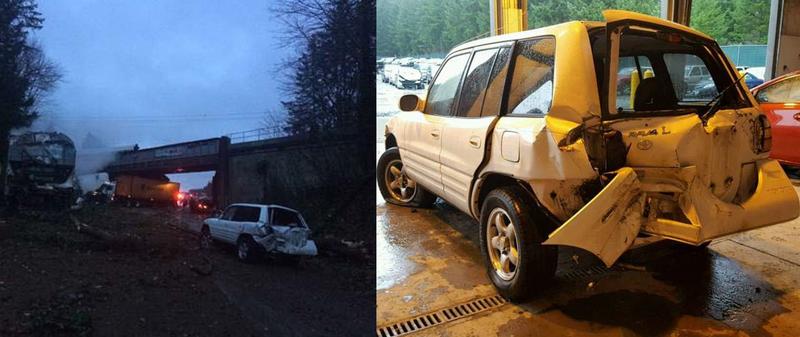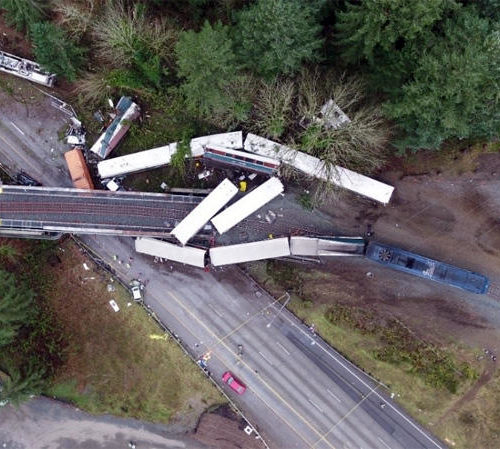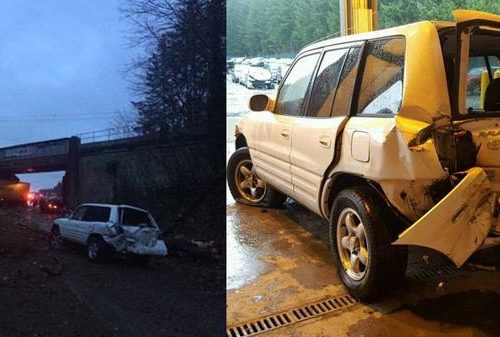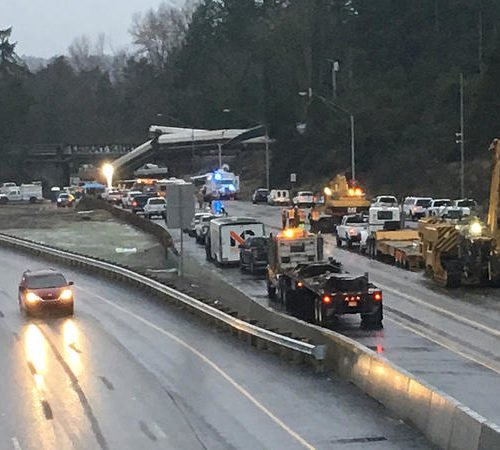
I-5 Driver Nearly Crushed By Derailed Amtrak Train Haunted By Memories
Listen
Cecilia Goetz was driving to work on the Monday before Christmas when a speeding Amtrak passenger train came flying off the rails above her. As part of that train crashed onto the rear of her vehicle, she thought she might die. Now she’s one of a growing number of crash survivors who have filed lawsuits against Amtrak.
Goetz was nearing the end of her regular Interstate 5 commute to Olympia when she passed under a railway bridge near DuPont, Washington at the very moment Amtrak Cascades train 501 derailed.
“I saw ahead of me that huge trees were snapping and falling onto the freeway. There were sparks going off. There were really loud noises,” Goetz recalled about the split seconds of the moment. “I realized a train that should have been crossing the freeway was falling onto the freeway.”
The 30-year-old state worker from Seattle said she had no chance to brake.
“I could feel the lights of the train shooting across my car,” Goetz said. “In my head, I thought I was going to be T-boned. That was the vision that came to my head and my body and brain just relaxed into it. I prepared for really extreme impact. I thought maybe that was going to be the end for me.”
One of the tumbling railcars struck and crushed the very back of Goetz’s Toyota RAV4. Her SUV spun around and skidded to a stop.
Goetz was transported by ambulance to a hospital in Puyallup where she was treated and released the same day. She said she has ongoing nightmares and is receiving care for lingering back and neck injuries.
“The emotional distress side of it has been challenging for me,” Goetz said. “There are things that I am working through.”
On Tuesday, the Seattle law firm Schroeter, Goldmark & Bender sued Amtrak on her behalf for unspecified damages. It’s at least the third lawsuit accusing Amtrak of negligence related to the derailment on December 18.
Amtrak has said it does not comment on pending litigation.
Three passengers on the train died and more than sixty suffered serious injuries. Goetz was one of eight additional people hurt in car versus train collisions on the freeway, according to a tally from the National Transportation Safety Board.
The NTSB continues to investigate the cause of the crash. So far, federal investigators have determined the train was traveling nearly 80 mph as it approached a curve and overpass posted with a 30 mph speed limit. It remains unclear why the locomotive engineer failed to slow down.
Amtrak Cascades train 501 was making its inaugural run with paying passengers on a new, faster route between Seattle and Portland using the Point Defiance Bypass. Three days after the deadly crash, Washington state’s secretary of transportation said passenger service on the bypass line will not resume until an automatic safety braking system is in place. The technology—called positive train control—is in the process of being installed, but was not activated at the time of the December derailment.
In an emotional interview late Tuesday, Goetz said the most burning question on her mind is why the train was traveling so fast going into the sharp curve.
Attorney Sandra Widlan has more questions that she and Goetz hope to answer through their lawsuit.
“Did Amtrak fail to properly train its workers on this new route?” Widlan said. “Why wasn’t positive train control on the train to warn the engineer that the train was going too fast and automatically slow it down? Is a culture of safety missing at Amtrak?”
Widlan said her law firm would like to hear from any witnesses at the scene who saw the railcar hit Goetz’s Toyota or may have seen how she got out of her vehicle. The crash victim is foggy about some details of what happened to her and needs help filling in gaps.
Related Stories:

Testimony Points To Human Error As Cause Of Deadly Amtrak Derailment In DuPont
Federal investigators have interviewed the engineer who was at the controls of Amtrak Cascades Train 501 that derailed last month south of Tacoma. The interview summary points more strongly to human error as the cause of the deadly wreck.

I-5 Driver Nearly Crushed By Derailed Amtrak Train Haunted By Memories
Cecelia Goetz was nearing the end of her regular Interstate 5 commute to Olympia when she passed under a railway bridge near DuPont at the very moment Amtrak Cascades train 501 derailed. She was lucky to survive.

First Responder Calls Train Derailment ‘Shocking’ And ‘Surreal’
An Amtrak Cascades passenger car dangles from an overpass over Interstate 5 in Pierce County, Washington, after a derailment on Monday morning. AUSTIN JENKINS / NORTHWEST NEWS NETWORK Listen As















